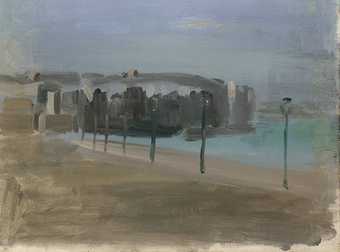There is a peculiar reticence about Victor Pasmore’s art that I have always liked. He was celebrated during his lifetime, of course, but not on the scale of Francis Bacon or Lucian Freud. He is the most self effacing British painter of the twentieth century, abandoning figurative painting in 1947, when he was 39, in favour of the abstract, behind which he concealed himself for five decades. Yet his style is as recognisable as Rothko’s, though more allusive, the pale colours often suggestive of melancholy and deep thoughtfulness.
There are two early paintings in the archive at Tate Britain that I have been privileged to look at. The first, a view of the church at Farleigh, dates from 1925 or thereabouts, when Pasmore was still a teenager and much under the influence of French Impressionism and Post-Impressionism. It could be by Vuillard, but already there are hints in its composition of the non-figurative work to come. The church, for example, is represented by a red steeple and a fraction of its roof, beneath which is the merest hint of stone walls and windows. The sky is blue, save for some distant clouds. The field in the foreground is parched, suggestive of the end of a particularly hot summer. It might be harvest time. There are several trees, one of which is in flower. It is a very accomplished little painting for one so young, but it is derivative. The other picture is smaller, but considerably more original. Pasmore is beginning to find his painterly voice. The date is c.1933. He would have been 25. The untitled depiction of the promenade at Dieppe presages the great paintings of a decade later, particularly The Quiet River: The Thames at Chiswick 1943–4, which I chose for the cover of my novel Gabriel’s Lament. The Chiswick painting has a solitary figure – a boy perhaps, sporting a cap – leaning on the parapet, staring out at the water. The colours – pink, grey, brown, light and dark blue – constitute Pasmore’s style of that time. The watery reflections are exquisitely rendered. Its predecessor has a mushroom-coloured promenade. Lamps and bollards are simply suggested. The sea is darkish blue, with waves that are whitish and brownish. The sky goes from grey to blue and there is a wispy cloud. Other clouds are forming on the left of the picture, and rocks can be discerned. The place is uninhabited. It is the work of an apprentice, but one already with a vision. Back in London, he was able to bring that vision to artistic fulfilment. I live near the Thames at Chiswick and often walk along the embankment, and if I stop at a certain spot quite near Fuller’s Brewery and look at the water when it is tranquil, I can see it, almost, with and through Pasmore’s eyes.
Pasmore, influenced by Cubism, moved away from the representational – if, indeed, he was ever wholly part of it. Churches, fields, trees, skies and people were sent packing from his art. In the Tate archive, one can see that art from its very inception – the path that led him to the beautiful abstraction of his maturity. The sketch is a reminder that great paintings, like great books or music, are often slow in coming into being. In an artist’s life, 1933 and 1943 can feel separated by a century.

